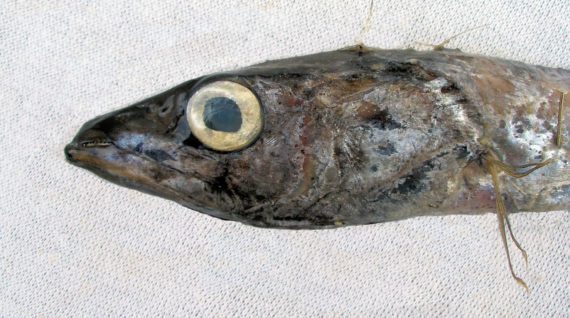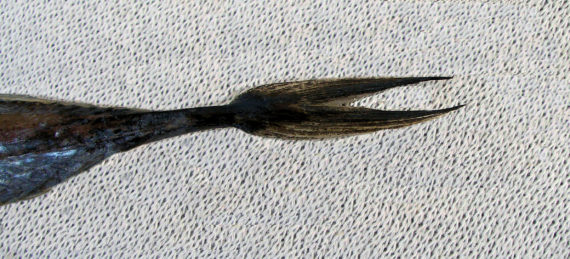Snake Mackerel, Gempylus serpens


 Snake Mackerel, Gempylus serpens. Fish provided by the commercial fishermen of the greater Los Cabos area, Baja California Sur, February 2011. Length: 33 cm (12 inches).
Snake Mackerel, Gempylus serpens. Fish provided by the commercial fishermen of the greater Los Cabos area, Baja California Sur, February 2011. Length: 33 cm (12 inches).
The Snake Mackerel, Gempylus serpens, is a member of the Snake Mackerel or Gempylidae Family, and is known in Mexico as escolar de canal. Globally, the Gempylidae Family includes the snake mackerels, oilfish, escolares, and cutlassfish with twenty-four members placed in sixteen genera. There is only one species in the Gempylus genus, the species described herein, which is found in all Mexican waters of the Atlantic and the Pacific Oceans.
The Snake Mackerel has a very elongated, slender, and compressed body that tapers toward the tail and has a mid-length depth that is 7.0% to 7.4% of standard length. They are dark brown to blackish in color with silvery reflections and gray-brown fins with dark margins. Their head is deep and large with a pointed snout and large eyes. Their mouth has a pointed projecting lower jaw equipped with large conical teeth spaced apart with a pair of fangs at the front of their top jaw. Their anal fin has 2 free spines followed by 1 spine and 10 to 12 rays and 6 or 7 finlets; their caudal fin is deeply forked; their first dorsal fin has 26 to 32 spines and is long and low; their second dorsal fin has 10 to 14 rays and is short followed by 5 to 7 finlets; and, their pelvic fins are minute. They are covered with small scales but smooth to the touch. They have 2 lateral lines, 1 mid-body and the other under their dorsal fin.
The Snake Mackerel is an oceanic species found from the surface to mid-water at depths up to 1,000 m (3,280 feet). They reach a maximum 1.42 m (4 feet 7 inches) in length and 3.0 kg (6 lbs 10 oz) in weight. As of January 1, 2024, the International Game Fish Association world record stood at 4.50 kg (9 lbs 14 oz) with the fish caught in coastal waters off Japan in November 2008. They are a solitary species and make vertical migrations toward the surface at night to feed. They consume cephalopods, crustaceans, and fish. In turn they are preyed upon by marlin and tuna. Reproduction is oviparous with each female releasing between 300,000 and 1,000,000 eggs in annual cycles. Their eggs and larvae are pelagic. As fish mature they move to deeper waters and the cone cells in their eyes change to rod cells. The Snake Mackerel is poorly studied with very limited information available about their lifestyle and behavioral patterns including specific details on age, growth, longevity, movement patterns, diet, habitat use, and reproduction.
The Snake Mackerel is a resident of all waters of the Atlantic Ocean including the Gulf of the Mexico and the Caribbean; in the Pacific Ocean they are found in all Mexican waters with the exception of the Sea of Cortez.
The Snake Mackerel can be confused with a series of fish from the Atlantic including the Atlantic Cutlassfish, Trichiurus lepturus, the Black Gemfish, Nesiarchus nasutus, the Black Snake Mackerel, Nealotus tripes, the Oilfish, Ruvettus pretiosus, the Roudi Escolar, Promethichthys prometheus, and the Striped Escolar, Diplospinus multistriatus as well as a series of fish from the Pacific including the Pacific Cutlassfish, Trichiurus nitens and the Oilfish, Ruvettus pretiosus, however, all these fish have 2 or less finlets following their anal and dorsal fins. In addition, the Cutlassfish do not have forked tails.
From a conservation perspective the Snake Mackerel is currently considered to be of Least Concern with stable, widely distributed populations. It is an important commercial species. They are caught as a by-catch in the longline tuna and swordfish fisheries and marketed frozen or as a component of sausages and fish cakes. In a limited number of cultures they are considered a quality food fish.